The emergence of the Internet has opened up numerous opportunities in various fields, including finance. However, traditional financial systems have yet to keep up with other technological advancements. Despite the widespread availability of the Internet, many individuals still need access to banking services, with an estimated 1.7 billion people worldwide being unbanked, according to the World Bank Group. In addition, although the Internet has made it possible to transmit information quickly, traditional financial transactions still require considerable time and cost.
In a decade, blockchain and other technological innovations have spurred a growing trend toward decentralizing the financial system. The development of Bitcoin Blockchain by Satoshi and its call for peer-to-peer transactions without intermediaries or centralized control was a significant catalyst for this trend. Likewise, Ethereum, another blockchain technology developed six years later, has emerged as a crucial element in the promising DeFi ecosystem. We now provide a comprehensive overview of blockchain technology, focusing on the DeFi ecosystem and its potential to provide financial access to the unbanked and enhance the current financial system.
Centralized finance (CeFi)
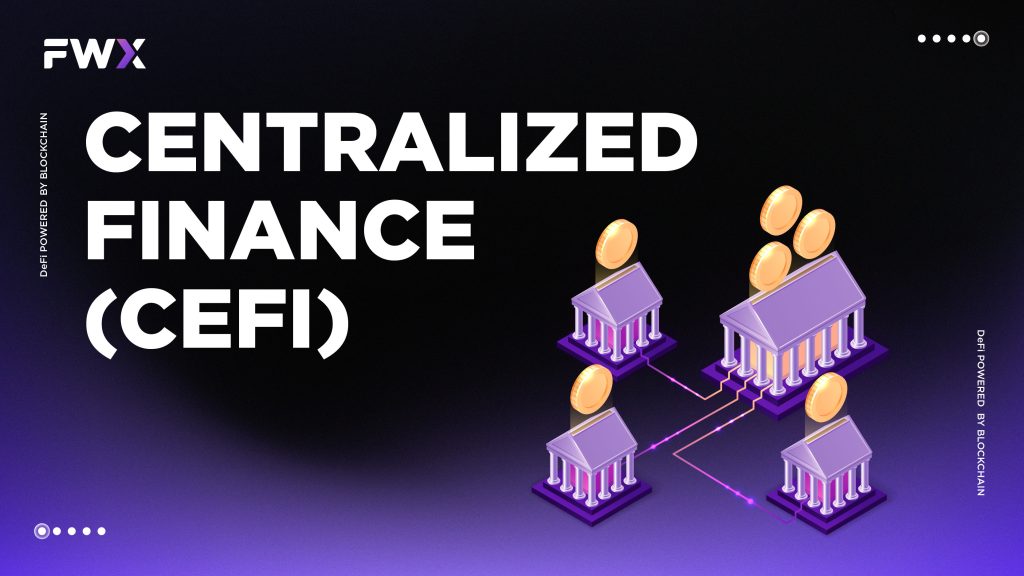
As per recent studies conducted by the World Bank Group, about 1.7 billion people worldwide still lack access to banking facilities. Moreover, centralized finance (CeFi) systems, despite their massive IT infrastructures and brilliant operators, suffer from various shortcomings such as high fees, inefficiencies, fraud, deception, and corruption. These issues, in turn, limit the accessibility of such systems to the majority of the population. Therefore, there is a need for decentralized finance (DeFi) solutions that are more accessible and transparent, which is the current cutting edge of blockchain technology.
As the economy runs on trust, financial service providers, banks, exchanges, and insurers play a crucial role in establishing that trust. However, these intermediaries can be powerful enough to charge unnecessary fees and exclude certain groups. Unfortunately, the current banking system is out of reach for millions of people, with 31% of adults globally being unbanked. This issue is due to factors like centralization, remoteness, intermediary costs, and a need for more trust in financial institutions. For people to manage their consumption and protect themselves from unforeseen events, access to basic financial services like loans and check-cashing is crucial. Nevertheless, the reality is that 1.7 billion people today need to be more educated and cannot benefit from the services provided by financial institutions.
Since the traditional banking system has high costs and regulations, many lower-income households have been excluded from accessing their services. This exclusion is seen worldwide and is particularly problematic for migrant workers, who often cannot open bank accounts due to the high costs associated with them. As a result, many of these workers have to rely on intermediaries to access financial services, which results in additional fees being charged. In addition, those who send money to their families overseas also encounter extra fees. As per the World Bank Report, global remittance reached US$689 billion in 2018, of which US$528 went to developing countries. This creates a monopoly in the market and results in high fees being charged by intermediaries such as Western Union and MoneyGram. As a result, low-income and migrant workers, who do not have access to national banks, are the most affected.
In today’s financial system, inequality is a significant problem, as there is a strong connection between poverty and the lack of access to banking services. Poor individuals constitute 75% of the unbanked population and cannot access essential social support services. Furthermore, women in developing countries represent the majority of the unbanked, comprising 55% compared to 46% of men. However, obtaining financial services comes at a high cost, including travel expenses, wasted time, and dealing with intermediaries and loan issuers who charge high fees for their services. This only exacerbates the poverty of the unbanked population.
Another limitation of the existing financial system is centralization. By having power centralized and controlled by legacy institutions, law firms, or regulatory bodies, the financial system has been exposed to data breaches, leading to the global recession of 2008, which exposed the weaknesses of centralization and intermediation. Moreover, centralization has hampered the growth of businesses worldwide, allowing banks to set regulations for payments and remittances, resulting in lost opportunities for more potential customers. The reasons are that blockchain technology is required.
Blockchain history
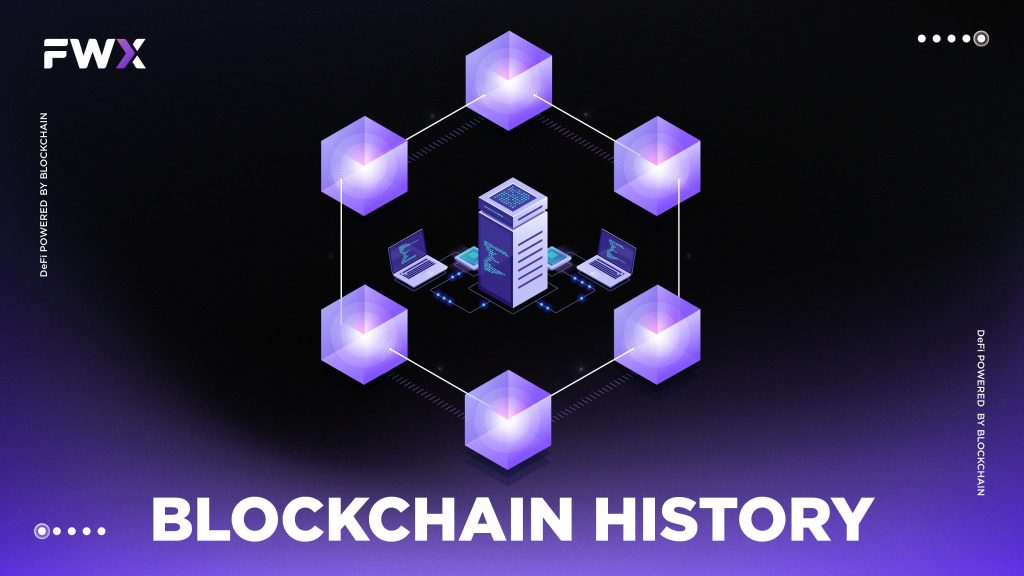
The expertise conveyed in this section focuses on the evolution and history of blockchain technology. The origins of blockchain date back to the 1990s, when Stuart Haber and W. Scott Stornetta first conceptualized a cryptographically-secured chain of blocks to ensure the integrity of document timestamps. They later upgraded the system with the Merkle Tree, which allowed for more efficient storage of documents on a single block. However, it was not until 2008 that the idea of blockchain technology came to fruition with the invention of Bitcoin by the anonymous developer Satoshi Nakamoto. The first blockchain was conceptualized in 2008 and has since evolved to include numerous applications beyond just cryptocurrencies. Nakamoto handed over the development of Bitcoin to other core developers, which resulted in the emergence of digital ledger technology (DLT) and the continued growth and expansion of blockchain history. Some researchers have a partitioned history of blockchain into three parts from 2008 to the present as follows:
- Blockchain 1.0 (2008-2012): Transactions
Bitcoin was introduced in 2008 as the pioneer application of blockchain technology, described as an electronic peer-to-peer system (Nakamoto, 2008). As of now, the market capitalization of Bitcoin is around 500 billion dollars (see also in CoinMarketCap). Later, it was discovered that Bitcoin’s underlying technology could be separated and utilized for numerous other applications, leading to the emergence of blockchain technology. Since the advent of Bitcoin, several applications have arisen aiming to exploit the principles and capabilities of the digital ledger technology DLT. Therefore, the history of blockchain technology comprises a long list of applications that have been developed over the years as the technology evolved.
- Blockchain 2.0 (2013-2016): Contracts
The second phase of the blockchain system involved using “smart contracts” on a second-generation blockchain. Vitalik Buterin, a developer and one of the early contributors to the Bitcoin database, envisioned a more flexible blockchain that could perform multiple functions in addition to being a peer-to-peer network. He developed Ethereum, a new public blockchain with more functionalities than Bitcoin, founded in 2013. Ethereum turned out to be a significant moment in the history of blockchain, as it used little computer programs to enable the representation of financial instruments, such as loans or bonds. Unlike bitcoin’s cash-like system, Ethereum’s technology allows for various uses. Ethereum’s market capitalization now stands at approximately 200 billion dollars, with numerous projects headed to the market.
- Blockchain 3.0 (2017-2022): Applications
As blockchain technology continues to evolve, it has become apparent that existing systems such as Ethereum and Bitcoin have limitations in their transaction rates. While Ethereum has improved its transaction rate to 15 transactions per second (tps), more is needed to keep up with the economy’s demands. Ripple has emerged as the fastest settlement system after VISA, handling 1500 tps. To meet the needs of a decentralized network, there is a need for Decentralized Applications (DApp) to run on a blockchain network, and they must have a user interface that accepts different programming languages. The current cutting-edge blockchain, DeFi, integrates decentralization, which will be discussed in detail later in this paper. The future of blockchain is moving towards a decentralized network that incorporates communications, data storage, smart contracts, and open platforms, allowing different blockchains to interact.
What is DeFi?
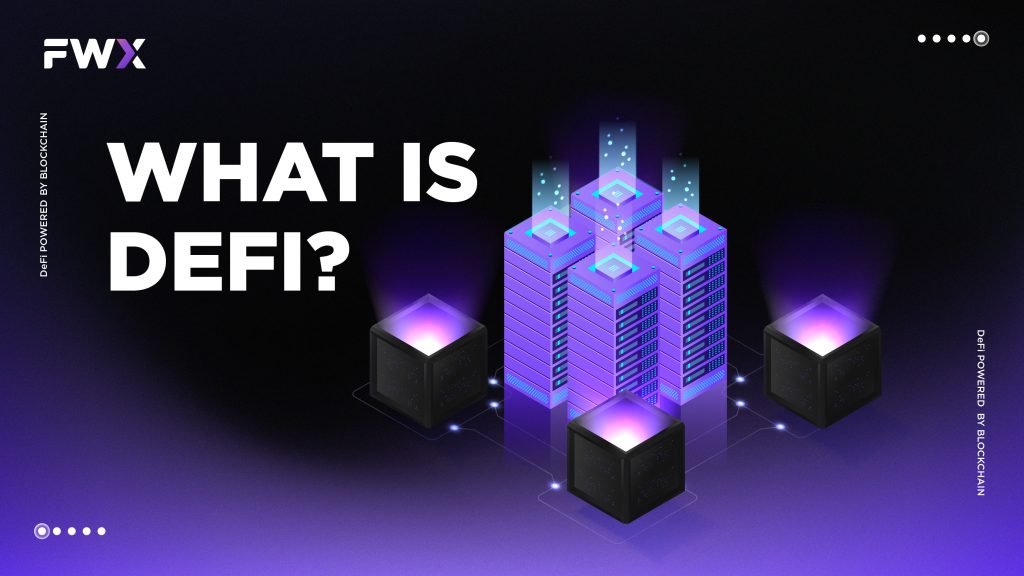
The concept of centralization has been integral to all economic systems throughout history. Governments, banks, and public companies have served as centralized authorities that people rely on to preserve value and ensure stability in the economic systems. The reason for this is that previously, we needed the technological capacity to engage in peer-to-peer transactions. Unfortunately, this trust placed in these centralized entities has given them considerable power, which has unfortunately been abused through imposing high fees, creating obstacles to entry and adoption, and restricting usage.
Decentralized Finance (DeFi) is an innovative and experimental approach to finance that differs from traditional finance in that it operates without the need for central authorities or intermediaries like banks, exchanges, or brokers. Instead, DeFi relies on smart contracts built on blockchain technology to provide a transparent and open financial system that anyone can access without blindly trusting centralized entities. The defining feature of DeFi is its “trustless” functionality, which allows users to have control over their assets and investments, with trust being verifiable through code. While decentralization does not necessarily mean there is no center, nodes have the freedom to choose the center, unlike centralized systems where the center determines the nodes’ actions. This approach allows everyone to participate in the financial system without the need for intermediaries.
In recent years, technological advancements have paved the way for a new financial system that operates in a decentralized manner. Known as Decentralized Finance (DeFi), this system combines traditional banking and investing services with decentralized technologies such as cryptocurrencies and DApps. It encompasses all decentralized products and services, including digital assets, smart contracts, protocols, and applications. DeFi aims to create a global financial ecosystem that is fast, efficient, transparent, and accessible to everyone without any central authority. Blockchain technology forms the foundation of DeFi, offering efficiency, transparency, and accessibility that are lacking in the current financial system. Unlike the traditional financial system, which banks, governments, and intermediaries manage, DeFi operates based on mathematical and computer science principles using blockchain technology.
DeFi ecosystem on Ethereum
Bitcoin and Ethereum are two different applications of blockchain technology. While Bitcoin is primarily used as a digital currency for transactions or as a store of value, Ethereum is a programmable blockchain that allows developers to create new products and applications. The software built on Ethereum is known as DApps, leading to the DeFi movement’s rise. DeFi aims to revolutionize the current financial system by making it more transparent, trustworthy, and decentralized through the use of DApps. In the Ethereum blockchain, there is no need for central authorities since it operates. The underlying infrastructure of the blockchain consists of a vast network of nodes, which are computers connected to the internet with software installed, and they process, verify, transmit, and store transaction data. Nodes are rewarded with Ether, the native cryptocurrency of Ethereum, for their participation in processing transaction data. Transaction data can include Ether as a value and code as information, which can trigger actions in the next layer of the Ethereum network. The Ethereum network also has a software layer that supports a programming language library, including Solidity, Viper, and others. With these programming languages, developers can write smart contracts that execute automatically based on the rules encoded within them.
Nick Szabo, an American scientist, proposed the concept of “Smart contracts” in 1994. His idea was to use computer codes to execute the functionalities of complicated contracts in securities trading, such as options and futures, without the need for a central authority. Instead, smart contracts enable the authorization of transactions and execution of contract terms within a trusted environment. Ethereum’s hardware and software layers work together to create a global decentralized supercomputer, the Ethereum Virtual Machine (EVM). EVM ensures flexibility and separation of each host and software application in the final layer of the Ethereum blockchain, where developers can launch third-party DApps like Crypto-Kitties and Augur. The Ethereum ecosystem supports various categories of DApps, including games, identity, health, property, and finance, which are integral to the DeFi space.
DeFi stack
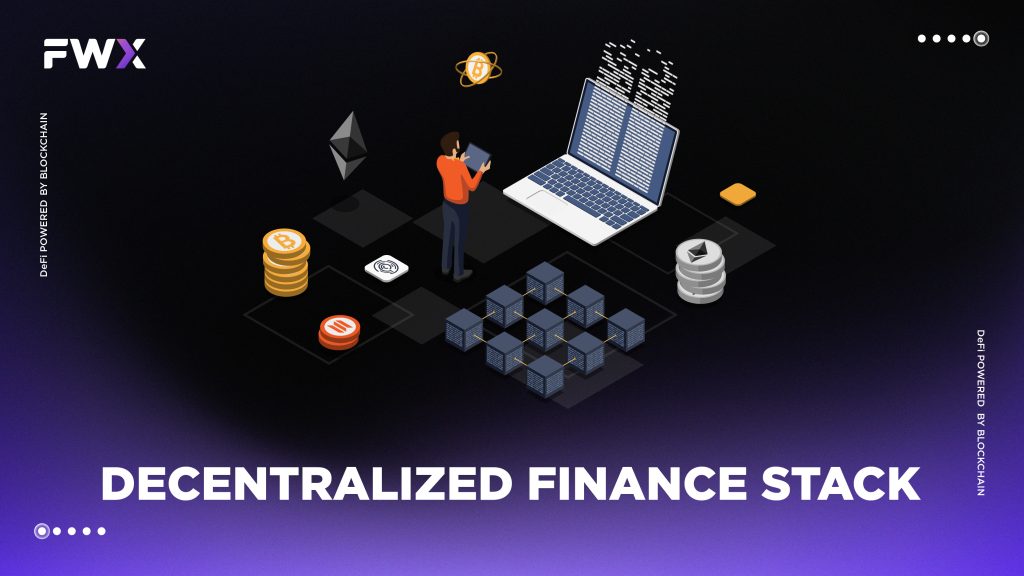
There are some critical components of the DeFi framework:
- Stable Coins
Cryptocurrencies are known for their high volatility, but stablecoins attempt to minimize fluctuations by pegging their value to stable assets such as Gold or the U.S. dollar. USDT, USDC, and DAI are examples of stablecoins that are pegged to the U.S. dollar and maintain the same value. There are two types of stablecoins: custodial-backed and algorithmic coins. Custodial tokens like USDT and USDC use stored fiat reserves to back the tokens 1:1, ensuring they maintain their peg. Algorithmic coins, such as DAI, are backed by cryptocurrencies and stabilized through algorithms and smart contracts. DAI uses digital coins to encourage arbitrageurs to maintain its peg to the U.S. dollar. While algorithmic coins exhibit some volatility and struggle to maintain the peg at times, custodial-backed tokens like USDT and USDC maintain a stable value.
- Decentralized Exchanges (DEX)
DEX are financial applications that permit users to exchange cryptocurrencies with each other without the involvement of any intermediary. Unlike centralized exchanges, DEXs like Uniswap and Kyber Network do not charge high trading fees and are fully collateralized, providing users with liquidity when placing orders. They allow users to trade their cryptos for small swap fees with minimal custodial risk while maintaining complete control over their assets. Additionally, some DEXs like Uniswap enable users to pool their cryptocurrencies and earn fees or to send a particular type of cryptocurrency while holding another. These decentralized exchanges play a vital role in the DeFi financial system, offering low fees, superior security, over-collateralization, and complete control of assets.
- Money Markets
In traditional finance, banks are the primary providers of liquidity. However, in DeFi, Money Markets play a vital role in offering liquidity and enabling users to borrow or lend funds without the involvement of banks or central authorities. In the DeFi ecosystem, projects like Compound utilize a liquidity pool model allowing users to borrow money without intermediaries. Lenders can earn passive income by contributing their cryptocurrencies to the pool, while borrowers can secure loans with interest rates determined by supply and demand. Unlike centralized banks, DeFi Money Markets are fully transparent. Anyone can check the number of loans issued from a lending pool to ensure that the liquidity pool is sufficiently over-collateralized. Furthermore, user credit history is not associated with DeFi Money Markets, which ensures borrower privacy.
DeFi in the future
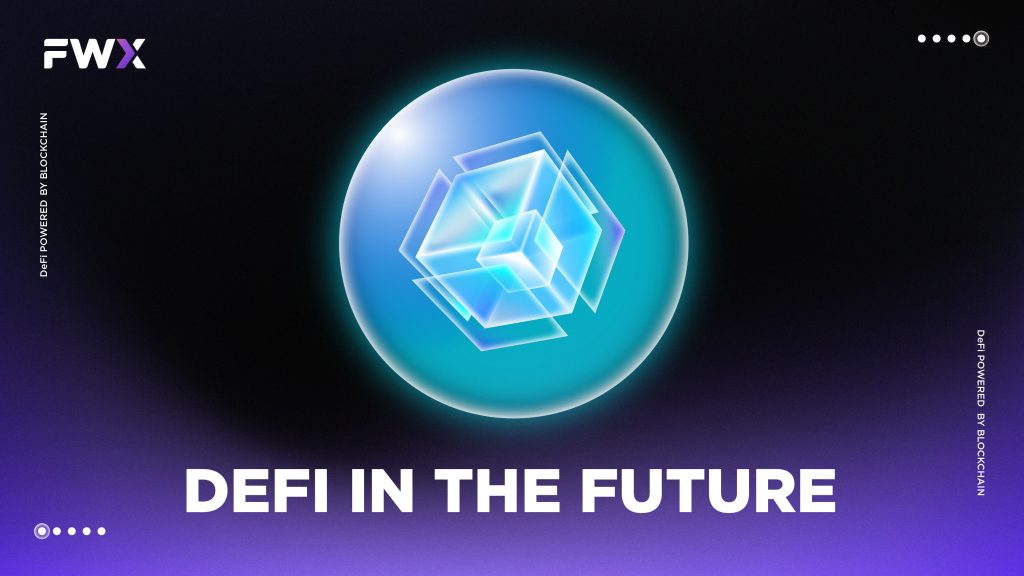
DeFi is a revolutionary concept that aims to address several issues present in the current financial system, such as financial exclusion, high transaction costs, slow speeds, and security concerns. The current financial system is dominated by large institutions that act as central authorities and hold significant power and control. DeFi seeks to eliminate or reduce this centralization by creating a transparent, permissionless, and open-source financial ecosystem accessible to everyone, including the 1.7 billion unbanked individuals. This new decentralized ecosystem removes wealth, status, and location barriers, providing access to financial services such as digital payments and remittances, allowing them to set up bank accounts and access loans to build businesses. The use of blockchain technology secures digital profiles, and global payments are affordable, with the average remittance fee expected to drop to 4%. Unlike centralized systems, DeFi operates on a decentralized network of computers, making data unbreachable. The combination of these solutions has profound implications for the financial industry, promising to make it more inclusive, accessible, and secure.


